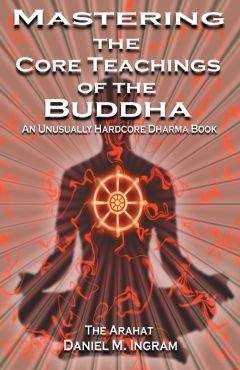Daniel Ingram - Mastering the Core Teachings of Buddha - An Unusually Hardcore Dharma Book
На сайте mybooks.club вы можете бесплатно читать книги онлайн без регистрации, включая Daniel Ingram - Mastering the Core Teachings of Buddha - An Unusually Hardcore Dharma Book. Жанр: Прочее издательство -,. Доступна полная версия книги с кратким содержанием для предварительного ознакомления, аннотацией (предисловием), рецензиями от других читателей и их экспертным мнением.
Кроме того, на сайте mybooks.club вы найдете множество новинок, которые стоит прочитать.

Daniel Ingram - Mastering the Core Teachings of Buddha - An Unusually Hardcore Dharma Book краткое содержание
Mastering the Core Teachings of Buddha - An Unusually Hardcore Dharma Book читать онлайн бесплатно
If you want insight into something, then looking into that aspect of things precisely is the best way to acquire that insight.
Once one has directly experienced these two insights, then the Three Characteristics begin to become obvious in stage 3. The Three Characteristics, which is exactly why the next factor of enlightenment is
How the Maps Help
called investigation of the truth, i.e. the Three Characteristics. Both the Seven Factors of Enlightenment and the insight maps tell you exactly what you are trying to understand and why. Their order is not arbitrary in the least.
You will not be able to understand the Three Characteristics directly without sorting out what is mind and what is body and the relationships between them. Without understanding the Three Characteristics, regardless of what you call them, you will not be able to go further and will not be able to get enlightened. The Buddha laid it all out step by step. While this may seem unromantic and perhaps even dry, it is also exceedingly practical and without a doubt the clearest presentation of exactly how to wake up that I have ever seen presented in any spiritual system, just so my biases are made perfectly clear. In short, these maps and techniques can be profoundly empowering.
Once the Three Characteristics begin to become clear, the mind naturally speeds up and becomes more powerful. This is because it finally begins to draw on its tremendous power to see things directly without processing them through thought. Anyone who has driven a car, played a video game or done just about anything else for that matter knows that you just have to do it, but if you tried to think about every little thing you were doing it would be impossible.
This increase in mental power due to non-conceptual and direct experience is related to the third factor of enlightenment, energy.
Energy may now even be blazing up and down one's spinal cord, the mind gets bright and alert, and soon energy is flowing naturally, as one begins to enter the early part of stage 4. The Arising and Passing Away.
Remember how this correlates with the second samatha jhana, where applied and sustained attention or effort are no longer needed? They just happen on their own to a large extent, and energy is naturally present. Thus, it all ties together.
The next factor of enlightenment is rapture, which comes to
predominate in the second vipassana jhana and the Arising and Passing Away just as it does in the second samatha jhana. Thus, all of the important advice about rapture given earlier applies to the insight maps in Part III. One is generally advised to avoid becoming a rapture or Kundalini-junkie in that stage, although I suppose if that is your primary 230
How the Maps Help
reason for meditating, it is certainly your right to do so. Just be wary of the inevitable crash.
During the mature Arising and Passing Away, as well as in
Dissolution, tranquility becomes important and more pronounced, but then becomes too strong in late Dissolution. Thus, it becomes important to build the sixth factor of enlightenment, concentration.
Finally, when the Dark Night really kicks in, as it will once one can again find one's objects and stay with them (Fear through Re-observation), then Equanimity in the face of all experience becomes vital for progress, as stated in Part I. Thus, Equanimity can arise and that Path can be attained.
As mentioned before, the maps fill in the seemingly huge, frustrating and nebulous gap from doing something like sitting on a cushion paying attention to the sensations of your breath and finally getting enlightened.
The maps also tell you exactly what the common errors of each stage are. They warn people about not getting stuck in 1. Mind and Body by solidifying it into a jhanic state, which it closely resembles.
They provide comfort and explanation when things might get jerky, unpleasant or even downright painful in the stage 3. Three
Characteristics. They admonish people not to get too fascinated with how much of a mighty meditator they might feel like in the stage of the 4. Arising and Passing Away, and to even examine the sensations that make up the seemingly wondrous and tantalizing corruptions of insight such as equanimity and rapture. They warn of the possibility of thinking that one is enlightened when going though that stage, as well as saying that it is normal for wild and sometimes explosive experiences to occur.
I spoke with a friend who basically wanted me to help him
rationalize that his recent A&P experiences occasionally allowed him to touch High Equanimity. My advice was that a much more helpful form of inquiry would be to notice the sensations of fascination with this issue and the sensations of the rest of his sensate universe come and go moment to moment. If he couldn’t manage this, he should be putting his time into trying to figure out how to get together enough vacation time and money to do another long retreat and/or how to increase his daily practice time and the thoroughness of his investigation.
231
How the Maps Help
The maps clearly state that the process is not a particularly linear one, and that after the highs of the Arising and Passing Away there usually follows times of difficulty when all of the spectacular power of the mind and the enjoyment of meditation gained in the Arising and Passing Away is likely to fade dramatically. They warn of the numerous difficulties that may or may not be faced in the Dark Night, as well as provide lots of information about how to deal with them. The most common mistake is failing to investigate the truth of sensations deemed undesirable. It is hard to get on more intimate terms with reality when we feel a bit too emotional, vulnerable, openhearted or shaken, and so progress in the Dark Night is not always easy.
While I do generally wish to avoid biting the hands that have fed me, I must say that not telling students about this territory from the beginning so as to give them a heads up to what might happen is so extremely irresponsible and negligent that I just want to spit and scream at those who perpetuate this warped culture of secrecy. While many teachers may not do so because they don’t think many people will ever get this far, that in and of itself is a scary assumption that should cause some serious questioning of their teaching methods, techniques, and perhaps even motivations.
Imagine that there is a meditation medication called Damnitall that is used to treat some form of suffering (perhaps it’s a pain medicine or an anti-depressant). However, in a subset of patients its long-term use is known to cause pronounced of anxiety, paranoia, depression, apathy, micro-psychotic episodes, a pervasive sense of primal frustration, pronounced lack of perspective on relationships, reduced libido, feelings of dissatisfaction with worldly affairs, and exacerbation of personality disorders, all of which can lead to markedly reduced social and occupational function. Imagine that these side effects are known to persist sometimes months and even years after someone stops taking the medication, with occasional flare-ups and relapses, with the only permanently effective treatment being to increase the dose, along with supportive care and counseling, and hope that these side effects pass quickly with little damage.
Now, imagine that you are living in the dark days of paternalistic medicine during which doctors are prescribing this stuff without fully 232
How the Maps Help
disclosing the potential side effects despite the fact that they are fully aware of them. Imagine that drug companies are not forced to disclose known side effects. Does anything in this scenario make you a bit uncomfortable? I should hope so!
Let’s say for the sake of argument that I am a fanatic who is blowing this thing way out of proportion. Let’s assume that Damnitall only causes these effects in 1 out of every 10,000 patients. Would you have these side effects included on the little piece of paper that comes in the bottle? Lets say it’s 1 in a 100? At what point does it become absurd that those doctors and drug companies are being allowed to get away with this? Unfortunately, I must admit that I do not know the exact odds of these side effects happening to you. I do know firsthand that they happen and that if you cross the A&P Event you are fairly likely to run into at least some of them.
These side effects are no fantasy. When they show up they are as real and powerful as if some dangerous drug had seriously skewed your neurochemistry, and I often wonder if that might be something like what happens. Thus, it seems only fair to have the same standards that we apply with such pronounced zeal and fervent litigation to drug companies and doctors also apply to meditation teachers and dharma books. For reasons unknown to me, this book is the first one I know of to spell out all of these things explicitly in language that everyone should be able to understand so that you can go into meditation having been fully informed of the risks and benefits and thus make informed decisions about your own practice. In the spirit of professionalism, I call on others who promote the dharma to adopt a similarly high standard for their own work.
Maps point out that people might be able to get stuck for a little while in Equanimity if they do not investigate the sensations that make up even equanimity, peace, relief, expectation, confidence, etc. The models also go into great detail about what actually happens in each stage of enlightenment and what does not happen (presented later), though this aspect of the maps is much more controversial than the maps of the progress of insight.
Thus, the maps at their best tell the meditator in clear and systematic ways exactly what to do, what to look for, why, and exactly 233
How the Maps Help
how not to screw up at each stage. They are no substitute for clear practice and investigation of the sensations that make up one’s experience, and they are poor aids to those who refuse to heed them and follow their advice. As I continue to mention, they can also be used as a basis for useless and even harmful competition between gung ho meditators with insecurity issues. It can and has been argued convincingly that one certainly doesn’t need to know these maps at all so long as one practices well. Despite the dangers of competition and over-intellectualization, the maps still have tremendous value when used as they were meant to be.
One very valid criticism of the maps, as I mentioned before, is that people are often very susceptible to suggestion, often called “scripting.”
Describing these stages can cause people to have something that resembles these experiences just because they have been told that they are expected. The part of the maps that deals with emotional side effects is notorious for causing this particular kind of mimicry. For example, it is basically impossible to sort out what is just fear and what is insight stage 6 (Fear) based upon the presence of fear alone. The aspect of the maps that deals with unusual raptures (both physical and mental) is less suggestible, and is a more reliable indicator of the stage of practice.
However, the fundamental increases and shifts in perceptual
thresholds are extremely hard to fake, particularly if you have access to a map that goes into the extensive details presented here. Shifts in perceptual thresholds are the most reliable markers on the path of insight, the Gold Standard by which these stages are defined. For example, if you recently saw very fine vibrations that changed frequency with the breath, then had a big zap-through, spaced out for a while, and now feel paranoid with some steady 5-7 Hz stuff that quickly leads to chaotic, edgy vibrations with complex harmonics, that’s very likely the insight stage Fear.
Thus, increasing one’s perceptual thresholds in terms of speed, consistency, and inclusiveness should always be the focus of one’s insight practices. Skilled teachers who use and are very good with these maps will take into account all three, i.e. emotions, raptures and perceptual abilities, along with the pattern of these that has unfolded previously, and use these to come up with an educated guess as to what 234
How the Maps Help
is going on with a student. With years of experience, we may eventually get good at doing this for ourselves. I have found that my guesses about my own practice are usually more accurate after I have had a year or two to reflect on what has occurred.
The best, most consistent practice I ever did was during a two-week Mahasi Sayadaw-style retreat in Malaysia. This was my third retreat ever, and I knew nothing whatsoever of the maps of the progress of insight, very little theory, and had done almost no reading of the old texts. I was simply doing noting practice. I had been told by a friend that if I noted quickly and accurately all day long from the time I got up until the time I went to sleep without breaks then good things would happen. Well, from my point of view, all sorts of strange and largely irritating things happened. However, I just kept noting quickly all day long regardless.
Things were getting pretty wild, then things calmed down a bit, and finally I hit a wall. I could barely practice at all. I would sit down and try to note and be walking away from the cushion within a minute and before I realized what was happening. My mind was so tight, irritated and buzzy that I felt I would soon explode. It was immensely frustrating.
That night the abbot played a scratchy old tape of a Burmese monk with a thick accent describing the stages of insight. It blew my mind, as he described exactly what I had gone through in the previous 13 days. I could clearly see how the stages he was describing had unfolded, exactly where I was and what I had to do. I was also astounded that the path could be so reproducible and straightforward, that I could just follow moronically simple instructions and have it all happen. Those who want to get lost in the reaction, “No, it isn’t so simple. Awakening is a great and intractable mystery! You are lying! It mustn’t be so!” should take a few moments to seriously question exactly how this disempowering and inaccurate view helps them feel good about themselves. They should then take a few moments to find another, more empowering view that helps them feel good about themselves, step up to the plate, and hit a home run.
With a very high level of faith in the technique and despite the extremely irritating restlessness that arose the moment I sat down, I resolved to sit on the cushion until I had passed Re-observation. It was horrible. I noted like crazy anyway. Within five minutes it broke, 235
How the Maps Help
everything opened up, and fundamental formations arose. Thus, knowledge of these maps is absolutely not necessary for progress but it may be helpful if it keeps one practicing and helps one realize that what is happening may be perfectly normal.
Unfortunately, the story continues on a dark note. I did not know these maps well at the time. I didn’t really appreciate what was happening, how close I was to a real breakthrough, and the possible implications of not doing so. The retreat ended one hour later, and I had very little time for practice when my rigorous travels resumed. I fell back, back into the Dark Night, and it began to really screw up my life. I won’t go into details, but I will say that I wish I had access to a friend with a solid understanding of these maps to help me keep what I was going through in perspective. As it was, I was largely blindsided. Since then I have met numerous people in similar unfortunate situations. The wish to help others avoid such difficult situations was one of my primary motivations for writing this book.
Похожие книги на "Mastering the Core Teachings of Buddha - An Unusually Hardcore Dharma Book", Daniel Ingram
Daniel Ingram читать все книги автора по порядку
Daniel Ingram - все книги автора в одном месте читать по порядку полные версии на сайте онлайн библиотеки mybooks.club.




